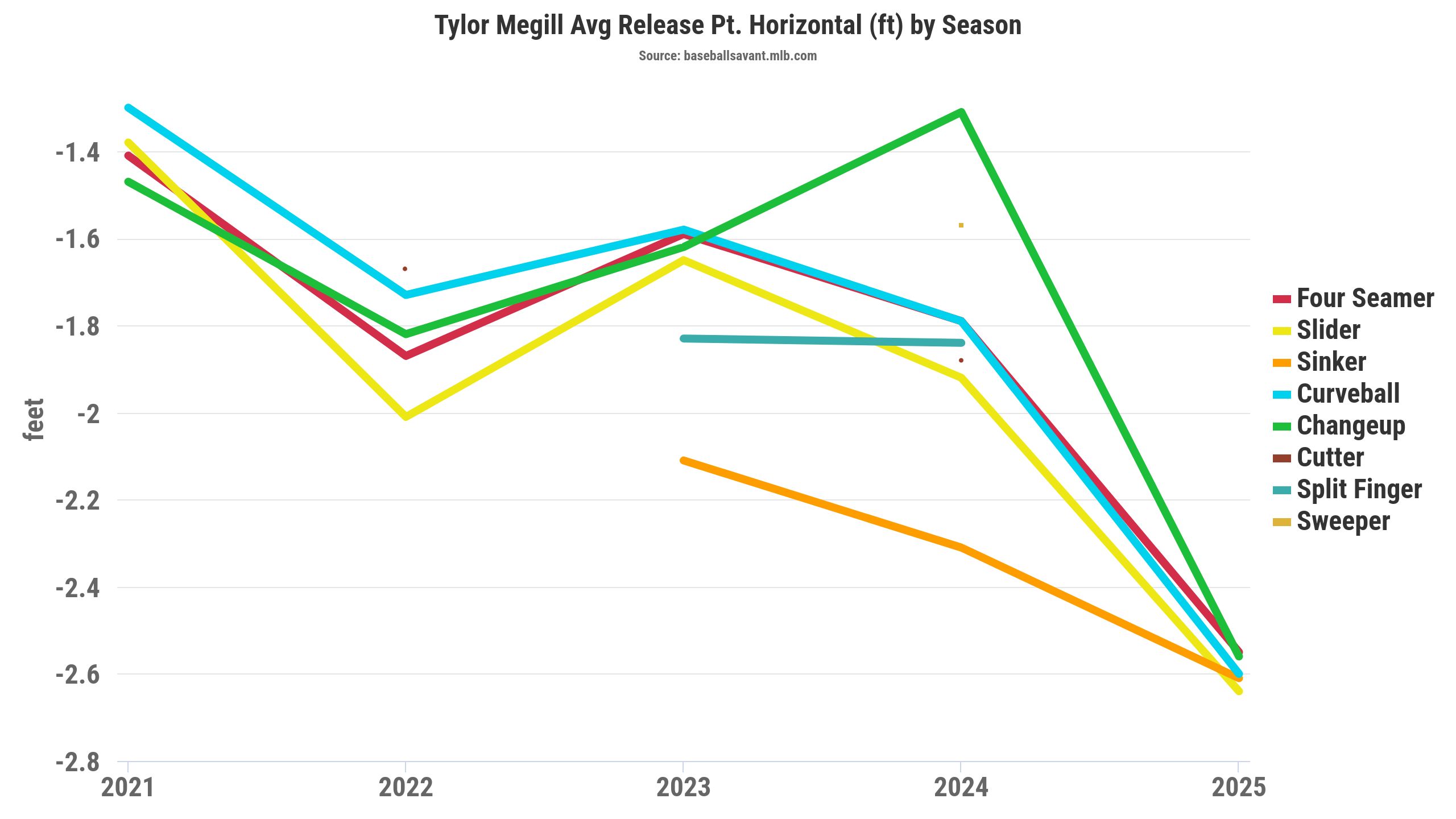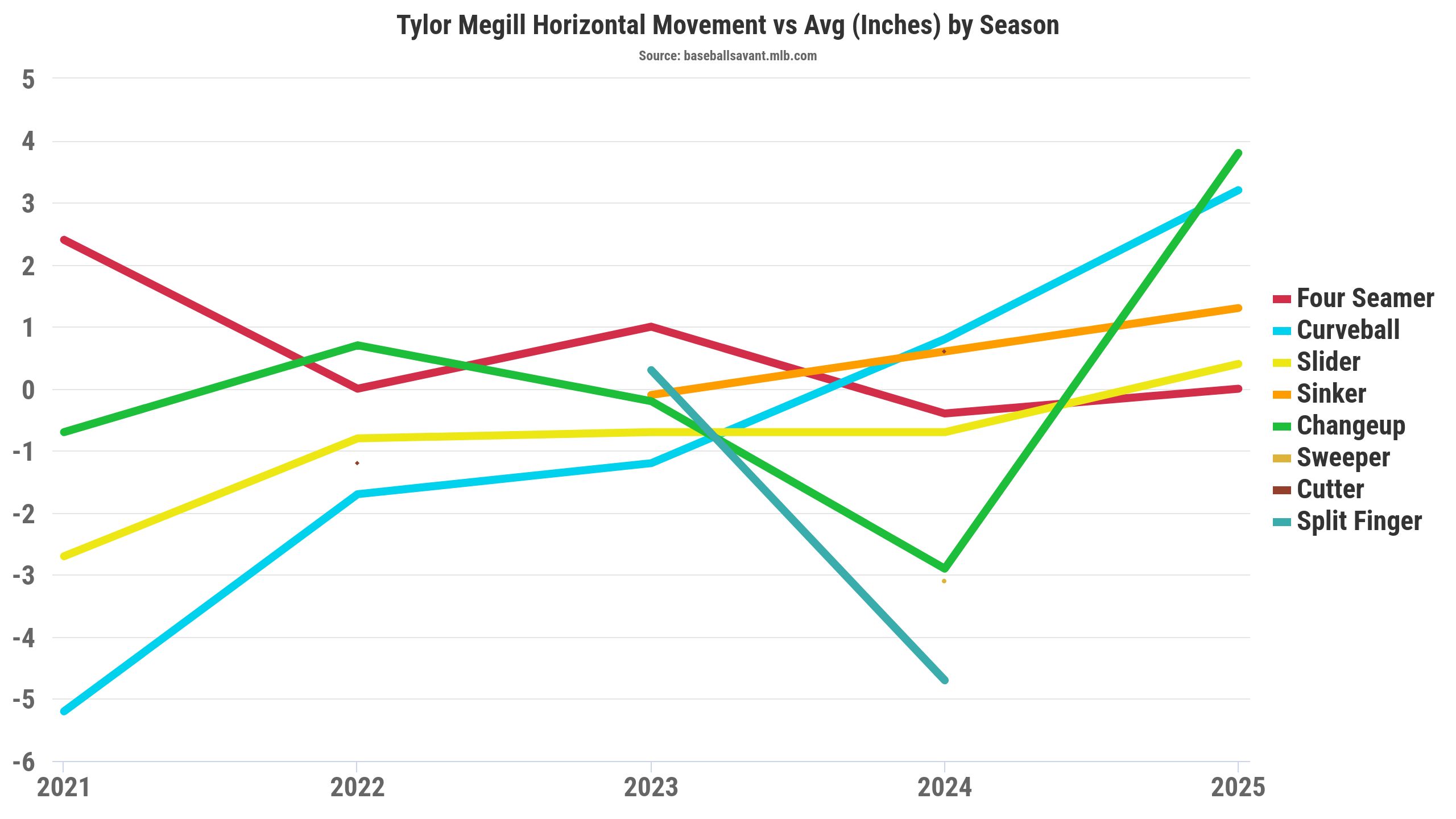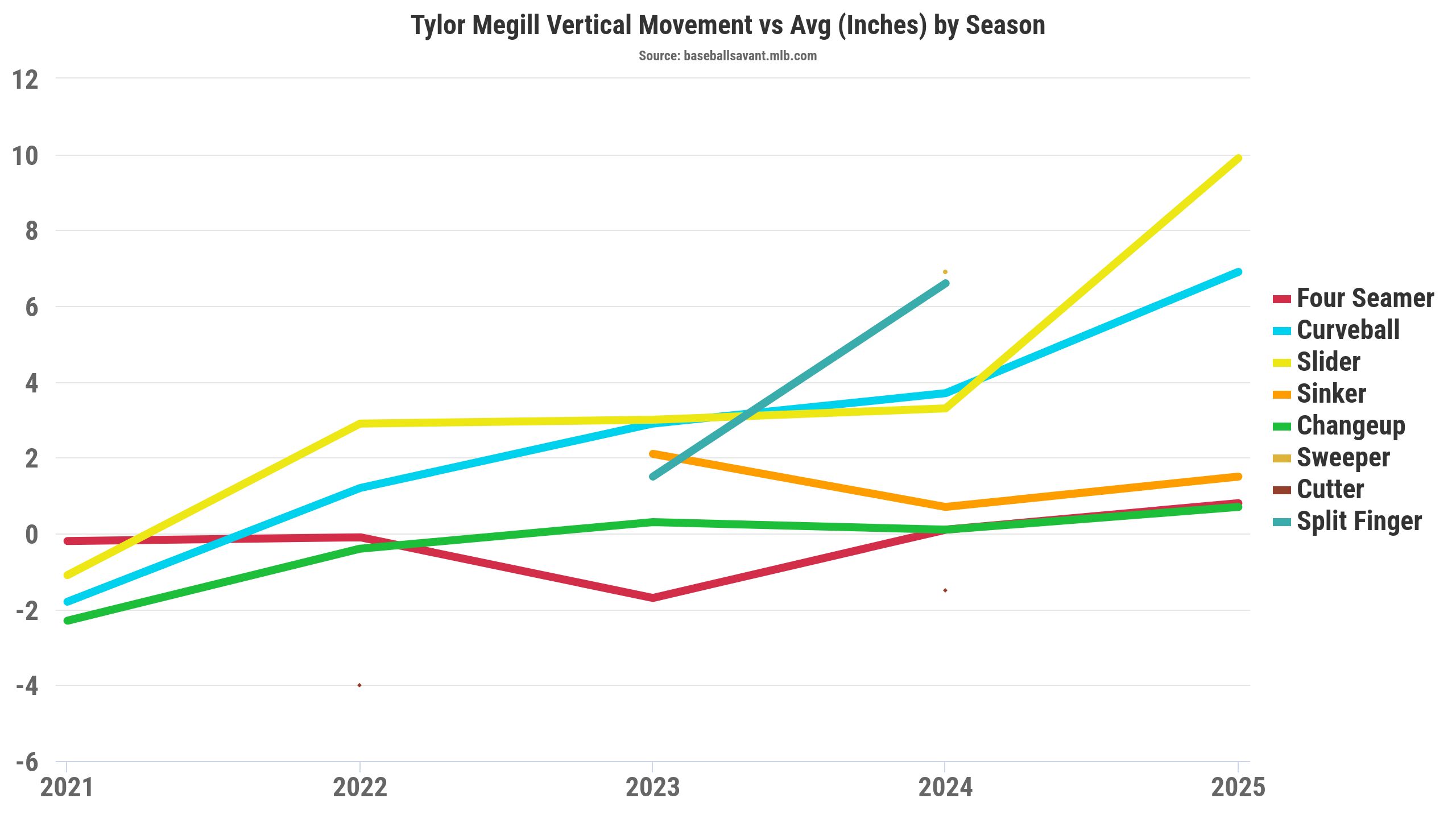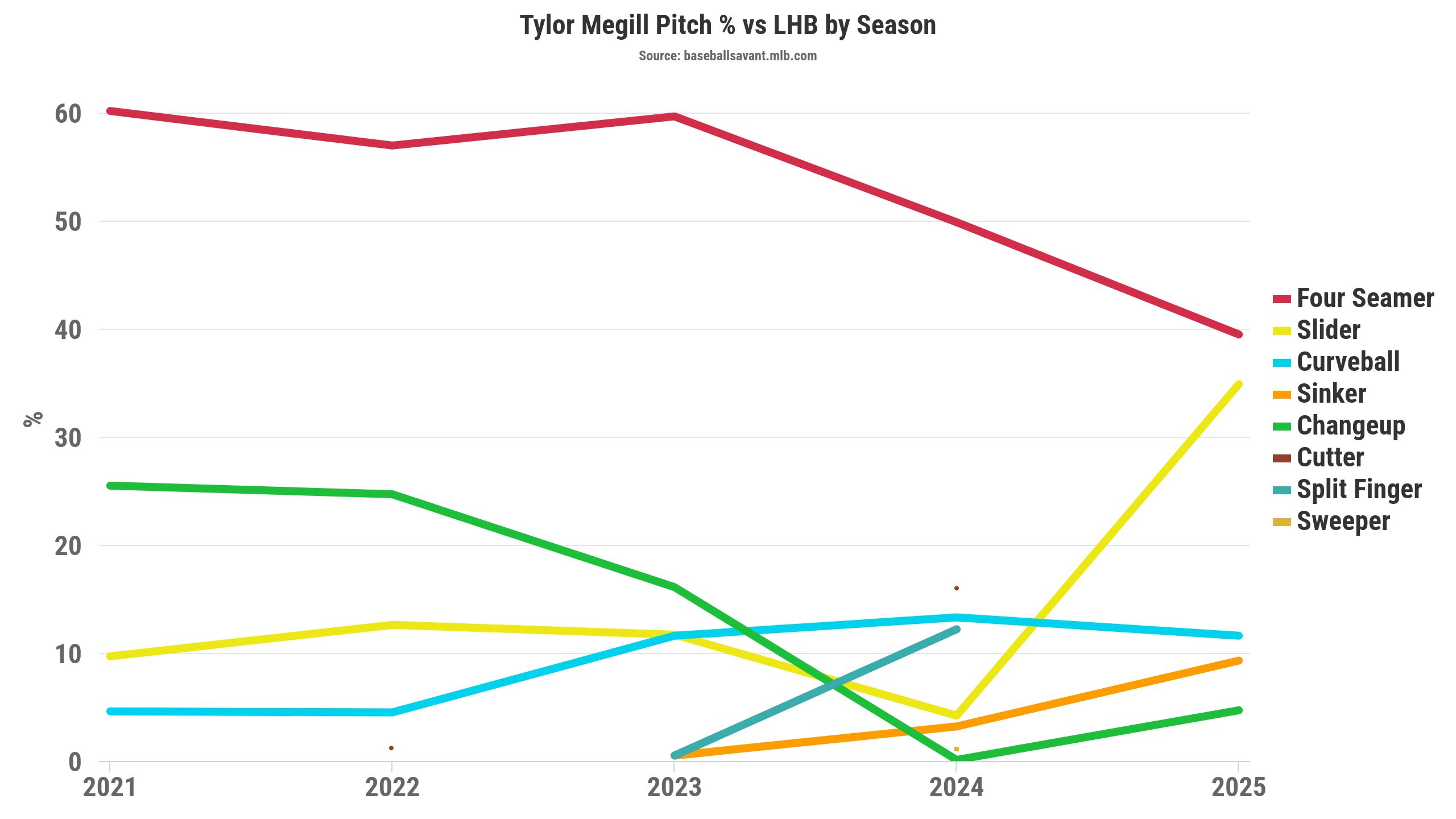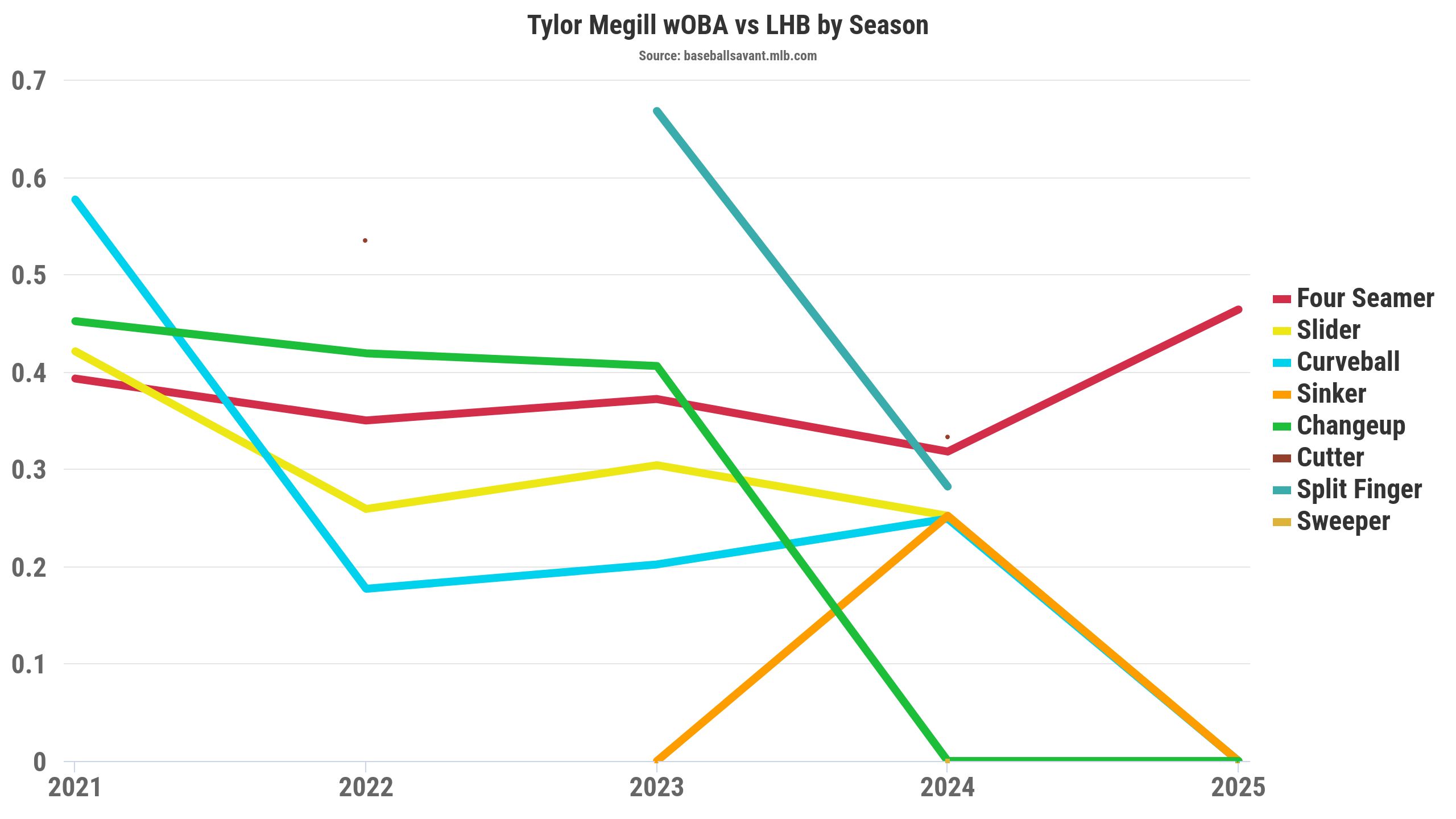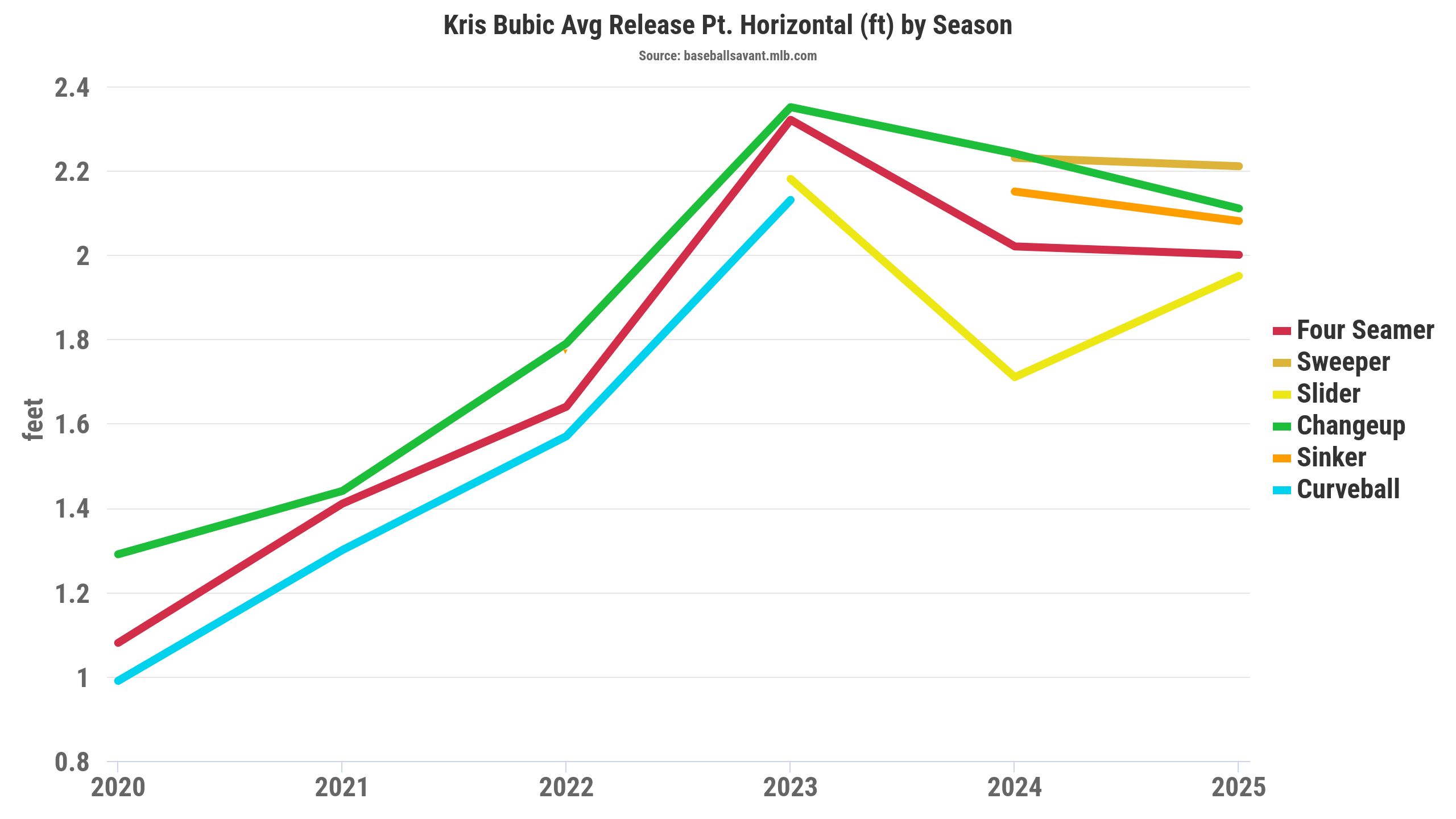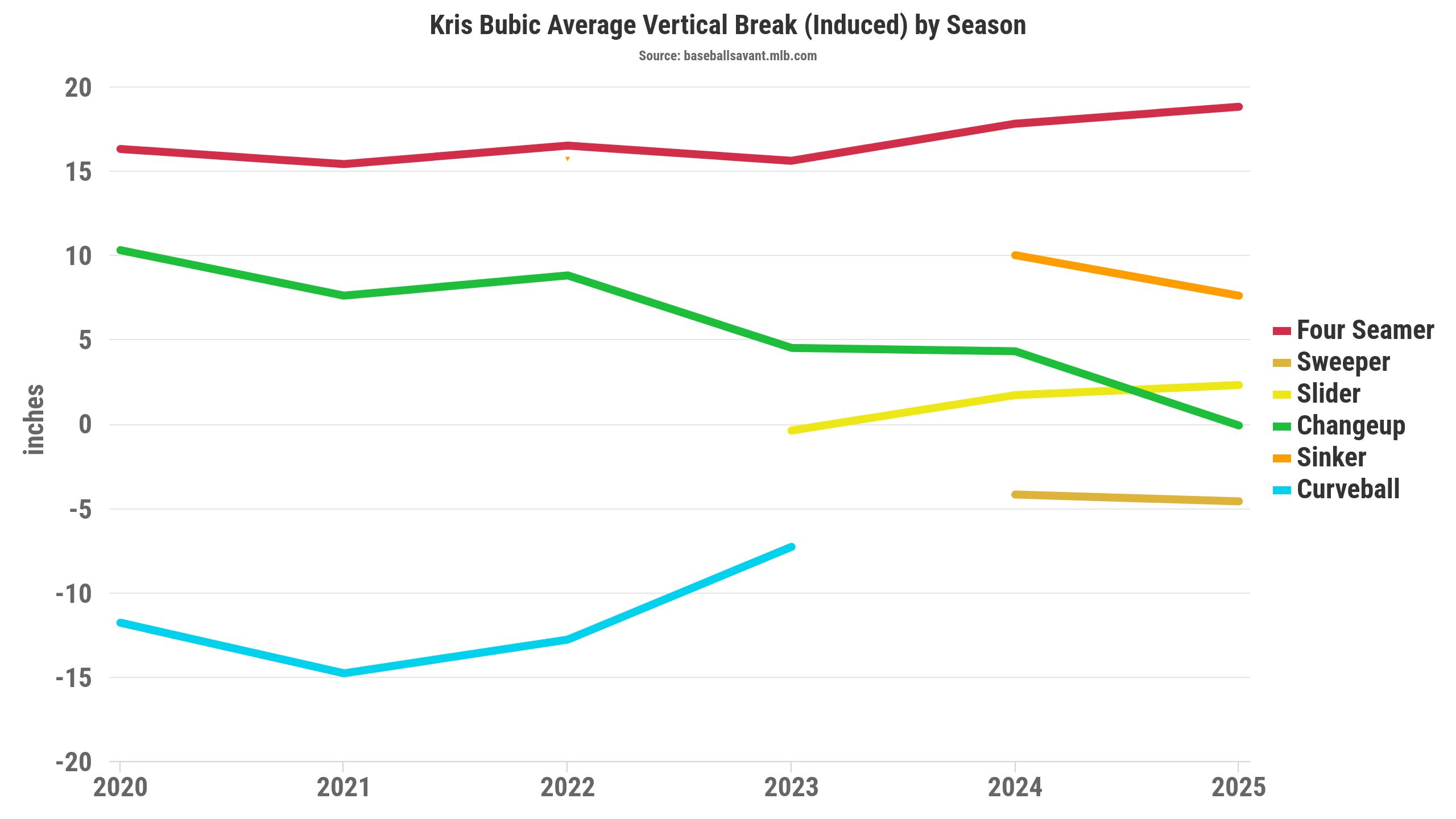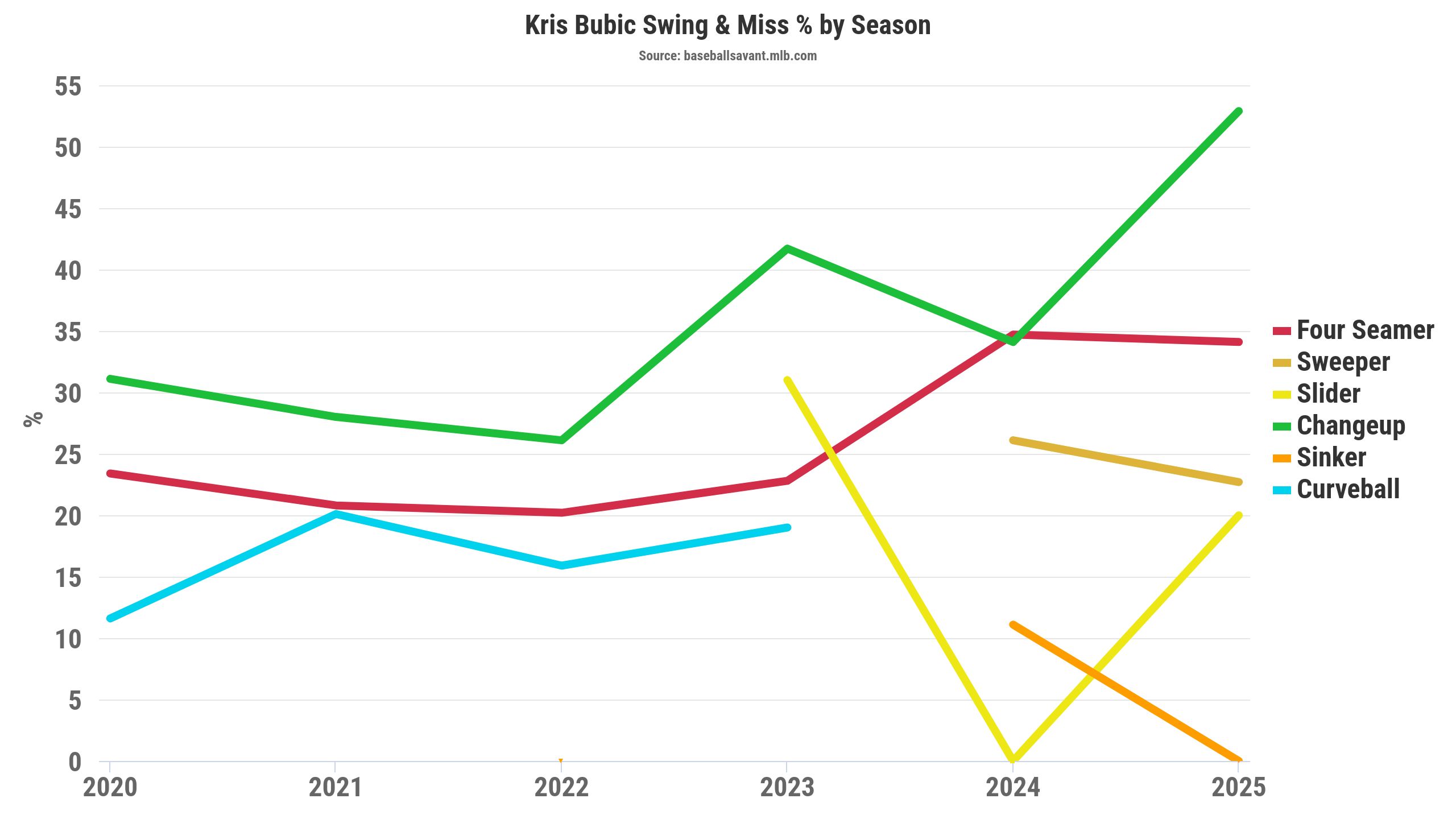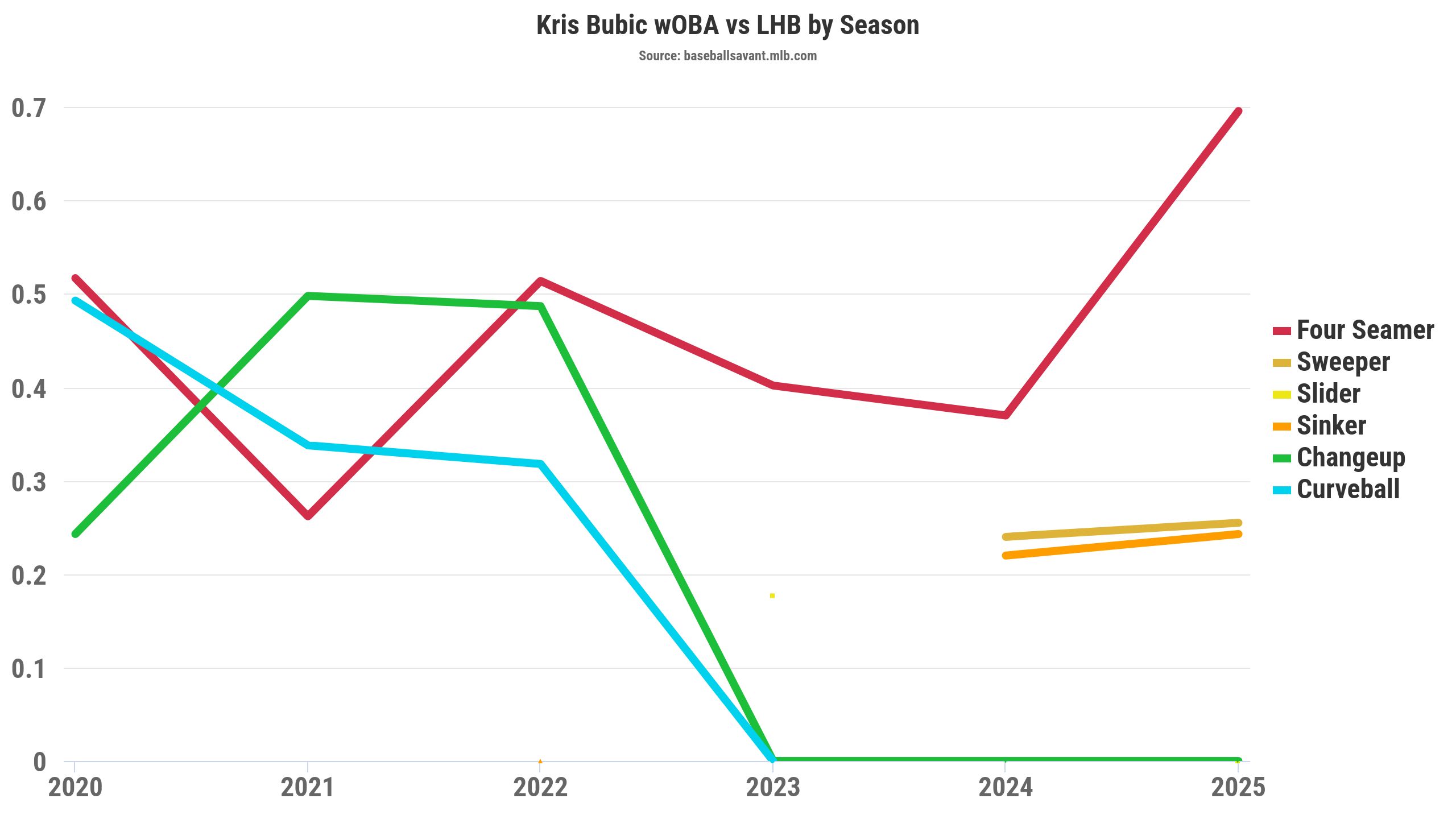Corbin looks at starting pitcher fantasy baseball breakout candidates and risers for 2025. His deep dive into Tylor Megill and Kris Bubic and their pitch mix.
Most know about my weekly "Starting Pitcher Arsenal Changes" article series during the 2025 fantasy baseball season. However, we'll sprinkle in ideas like the one on bat speed and bat tracking last week. Since I've been spending tons of time on starting pitchers and threads, why not do somewhat of a deep dive into two starting pitchers?
These starting pitchers have been successful early in 2025. Has the process aligned with the results? Since it's early, we're looking for release point changes, arm angle differences, velocity, and movement changes. If we find significant release point shifts, it can potentially impact their movement profiles in 2025.
Pitchers can make notable changes in smaller samples, so let's see if we can find something with these starting pitchers. Let's look through my process of examining starting pitchers and their arsenals. Reach out to me on X if you have questions about a pitcher. This is the first article of this series for the 2025 season. Thank you for reading!
Be sure to check all of our fantasy baseball lineup tools and resources:- Fantasy baseball trade analyzer
- BvP matchups data (Batter vs. Pitcher)
- PvB matchups data (Pitcher vs. Batter)
- Who should I start? Fantasy baseball comparisons
- Daily MLB starting lineups
- Fantasy baseball closer depth charts
- Fantasy Baseball live scoreboard
- Fantasy baseball injury reports
Tylor Megill's Horizontal Release Point Change
Injuries have been an issue for Megill, with biceps tendinitis and a strained shoulder in 2022 and a shoulder strain again in 2024. Megill performed well in his first two outings of 2025, but let's examine his early sample. His xERA (3.80) in 2025 is similar to his 2024 numbers (3.84), though we shouldn't use xERA or any other expected ERA metrics too heavily yet.
Has anything changed in Megill's arsenal or release point? Megill's horizontal release point dramatically shifted to over 8.5 inches (8.8 inches) farther from his midline. Theoretically, that should lead to more horizontal movement on his pitches.
Megill's Pitch Movement Profiles
Megill's curveball maintained the downward movement and gained two mph of velocity. Furthermore, Megill's curve added two inches more glove-side sweep than in 2024. It's early, but the curveball movement profile went from slightly above-average to high-end drop and sweep. Though Megill hardly uses the changeup, it generated four to six more inches of arm-side fade versus the previous two seasons.
Though Megill's raw inches total of downward movement hasn't changed, it's much more than the average curveball. Meanwhile, Megill's slider added nearly 10 inches of vertical drop (47.5 inches), leading to elite levels of downward movement.
Based on Megill's curveball and slider movement profiles, they're meshing closer together. That's evident in the pitch separation from 2025 and 2024, seen below. It aligns with the curveball velocity gains, and the movement profiles nearly mirror each other.
Maybe it's fluky to have the slider and curveballs aligning closer in movement profiles or something actionable via Megill's release point changes. Sometimes, the release points, arm angles, and movement profiles can provide a better idea of the why behind a starting pitcher's successes or struggles before we dig into the pitch mixes.
Megill's notable pitch mix change involves throwing more sliders (34.9 percent) to left-handed hitters. He mixed in a mediocre cutter (16 percent) versus lefties last season, resulting in a .333 wOBA (.366 xwOBA). His previous career-high slider usage versus lefties hovered around 11-12 percent in 2022-2023, and the results were decent (.202 wOBA, .210 xwOBA in 2023).
Since the curveball typically performed well, let's touch on his other breaking balls' success against left-handed hitters. Megill's curveball has been one of his most effective offerings against opposite-handed hitters, allowing a .249 wOBA (.279 xwOBA) in 2024 and .202 wOBA (.210 xwOBA) in 2023.
We highlight him throwing fewer four-seamers and more breaking balls against lefties because of the movement profile changes for those in 2025.
Summary
After studying injuries throughout the offseason, I learned that having a shoulder strain twice over the past two seasons can make a pitcher quite risky. Thankfully, Megill's draft price included the injury and skill concerns. Megill might not have ace-like potential, but he made drastic horizontal release point changes, impacting his pitch movement profiles.
That's something to buy into because those inputs directly impact a pitcher's stuff to garner more whiffs, specifically via the curveball and slider for Megill.
Against the Marlins on Wednesday, Megill pumped four-seamers a whopping 73 percent of the time to left-handed hitters. The slider and curve typically were more involved, but his four-seam was the main whiff pitch, eliciting a 20 percent swinging-strike rate versus a career average of 9.8 percent.
Megill had the four-seamer cooking on Wednesday, with an additional inch of IVB while locating it in the upper third of the zone. Furthermore, seven of Megill's nine whiffs came against lefties on Wednesday. It's early, so the pitch mix data can be fluky to rely on, though it shows he can find success with the heater, too.
Kris Bubic's Improved Four-Seamer
Besides researching the induced vertical break, we want to examine how and why a pitcher's four-seamer improved. Bubic teased us in 2024 as a reliever with his four-seam IVB (17.8 inches) via a horizontal release point change over 3.5 inches closer to his midline. That led to having a slightly higher arm angle in 2024 (43.8 degrees) versus 2023 (36 degrees).
Bubic maintained the horizontal release point adjustments from 2024 into 2025, with a slightly lower arm angle, leading to another inch of four-seamer IVB. That led to Bubic's four-seam IVB going from above-average to high-end or near-elite in 2025. Unsurprisingly, Bubic's four-seam elicited a 15.4 percent swinging-strike rate, aligning with 2024 (15.5 percent), over six points above his career average (9.1 percent).
Speaking of vertical movement shifts, let's highlight Bubic's changeup, adding over four inches of downward movement in 2025 (37.8 inches) versus 2024 (33.1 inches). That led to Bubic's changeup turning into a near-elite pitch via the movement profiles. Unsurprisingly, Bubic's changeup generated a whopping 26.7 percent swinging-strike rate in 2025 versus 18.2 percent in 2024 and 14.6 percent in his career.
Bubic's Sweeper
After primarily throwing four-seamers and changeups while mixing in a curveball, Bubic used a sweeper over the past two seasons. It could be a pitch classification update, but we've seen him develop a sweeper that's in between his past curveball and slider. Bubic's sweeper added an inch of downward movement, plus over three inches of glove-side sweep versus 2024.
Since Bubic's four-seam and changeup tend to run toward his arm side, the sweeper provides a breaking ball moving toward his glove side. Theoretically, Bubic becomes less predictable with his three-pitch mix, attacking either side of the plate. Though Bubic's sweeper doesn't generate the same levels of whiffs as the four-seam and changeup, it induces weaker contact.
That's notable via Bubic's batted ball results against left-handed hitters, with the sweeper allowing a .255 wOBA (.211 xwOBA) in 2025, similar to his 2024 results (.240 wOBA, .176 xwOBA). Interestingly, Bubic mixed in a slider (19.3 percent) versus left-handed hitters, being somewhat of a bullet slider where it doesn't sweep as much as the sweeper.
Keep tabs on the harder slider because that might confuse hitters when expecting the sweeper.
Summary
Bubic maintained the near-elite strikeout skills as a reliever (15.7 percent SwK) into a starting pitcher (15.5 percent SwK) in 2025. Besides the release point and movement profile changes, Bubic's control improved over the past two seasons, evidenced by a 30.6 percent ball rate. For context, Bubic's career ball rate sat at 36.7 percent.
If Bubic maintains near-elite control while continuing to elicit whiffs, there's another level of upside as a starting pitcher. As a Bubic lover in the offseason, it's fun for the data and metrics to align with him in the following season. That's an example of the process leading to the results. It's worth price-checking and buying high on him if you're having FOMO.
Download Our Free News & Alerts Mobile App
Like what you see? Download our updated fantasy baseball app for iPhone and Android with 24x7 player news, injury alerts, sleepers, prospects & more. All free!


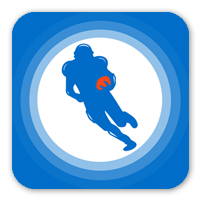



 RADIO
RADIO








